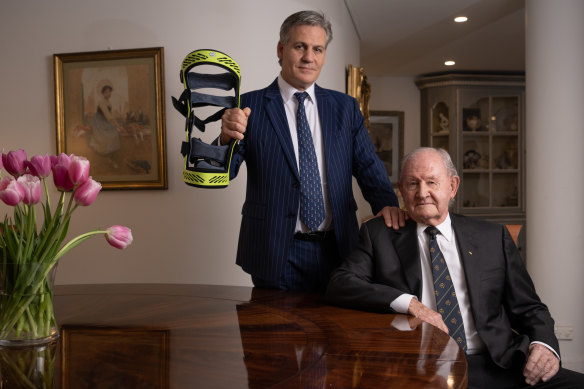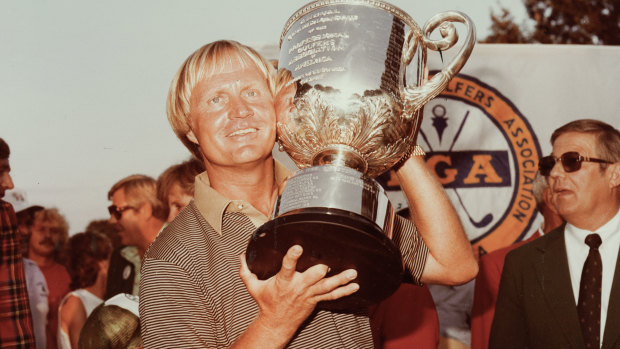Pioneering knee surgeon Merv Cross – who was on speed dial for everyone from Kerry Packer to battling park footballers – has passed away after a long battle with lung disease. He was 82.
A former rugby league forward for South Sydney, Eastern Suburbs and North Sydney, Cross revolutionised keyhole surgery and arthroscopic ACL reconstruction for some of the world’s greatest athletes.

Merv Cross, seated, with son Tom.Credit: Wolter Peeters
He was surrounded by his family when he died on Friday night, including his son Tom, who is equally respected in the field of sports medicine.
“It was a beautiful death,” Tom told this masthead. “He died courageously, with grace, and nothing unsaid … He was a giant in orthopaedics for 50 years. Every patient, to him, was a privilege. It was an honour to treat them.”
Cross was born in the NSW northwest town of Warialda on July 3, 1941, before moving with his parents to Sydney when he was four.
He attended Marcellin College at Randwick before studying medicine at Sydney University while juggling his rugby league career.
‘He would treat people in the housing commission in Redfern just as much as Jack Nicklaus.’
Tom Cross, on father Merv
He was a feared defender before his calling in medicine, which included hundred-hour weeks at St Vincent’s Hospital, forced him to give it away.
A shoulder reconstruction that went wrong pushed him towards the field of orthopaedics.
He was initially mocked for some of his methodology but soon proved to be a pioneer, refining the use of arthroscope to assess the damage to an athlete’s knee.
He established a roll call of high-profile athletes, including cricketers Dennis Lillee, Michael Holding and Clive Lloyd, Swans legend Paul Kelly, surfer Tom Carroll and rugby league internationals Wayne Pearce, Gene Miles and Justin Hodges.
“He gravitated towards orthopedics because he was an athlete himself,” Tom said. “The best orthopaedic surgeons are often former athletes: great hands, co-ordination under pressure. Merv would go to another level when the pressure was on.”
In the 1970s, Cross took a phone call from the country’s richest man, Kerry Packer.
“Jack Nicklaus is in town,” Packer told him. “He’s got a bad back and we can’t get him out of bed.”
Nicklaus, the world’s best golfer, was in town for the Australian Open.
“Where should I meet him?” Cross asked.
Soon enough, Cross was driving into Packer’s estate atop Bellevue Hill and manipulating Nicklaus’ back. Two days later, Nicklaus won the tournament.

Jack Nicklaus after winning the 1980 PGA Championship at Oak Hill.Credit: Getty
Cross’ patient list wasn’t confined to those with the biggest names or deepest pockets. Because he came from nothing, he would treat people from all walks of life.
“He would treat people in the housing commission in Redfern just as much as Jack Nicklaus,” Tom said. “Same kindness, same empathy and care and devotion to the patient. He looked after a lot of people for nothing. If they had financial difficulty, he’d do it for free.”
Cross was an NRL board member in the early 2000s and, in 2007, inducted into the American Journal of Sports Medicine’s Hall of Fame.
He retired in 2011, powering to the line with a full operating list of 11 cases, but remained a powerful influence teaching generations of surgeons from Australian and the rest of the world.
His final contribution was a revolutionary bracing technique, developed alongside Tom, that allows ACLs to heal without invasive surgery.
In 2014, Tom was at the Stadium Clinic at Moore Park, consulting 19-year-old Emma Rodger, who had ruptured her ACL playing netball. She was crying, knowing two of her teammates had undergone ACL surgery on their knees, only for both procedures to fail.
“Is there another way?” she asked.
Cross was in the clinic doing rehab after having his knees replaced. He heard the crying and pulled back the curtains.
“There is another way,” he said. “In the 1970s, we’d put plaster on patients that didn’t want surgery or who weren’t eligible. Some got better, others didn’t. If it doesn’t work, you haven’t burnt any bridges. You’ve just lost a bit of time. You can always have surgery.”
The “Cross Bracing Protocol” was born and, since then, has allowed hundreds of athletes to return to playing without surgery.
Cross is survived by his wife Virginia and children Joe, Tom, Belinda and John and two grandchildren: Dr Matthew Dowsett and Stephanie Dowsett, a final year medical student.
Two weeks ago, Tom asked his father if he had any regrets.
“None,” Cross replied in his matter-of-fact manner. “I would’ve done something about it at the time.”